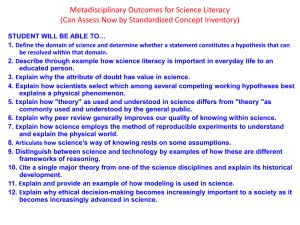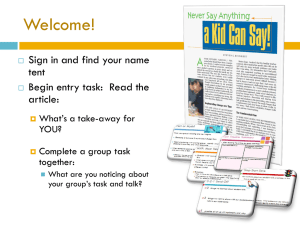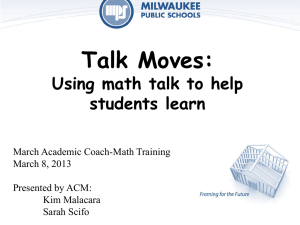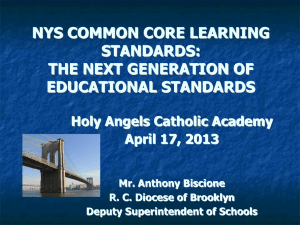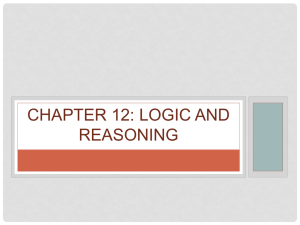Argumentative Writing
advertisement
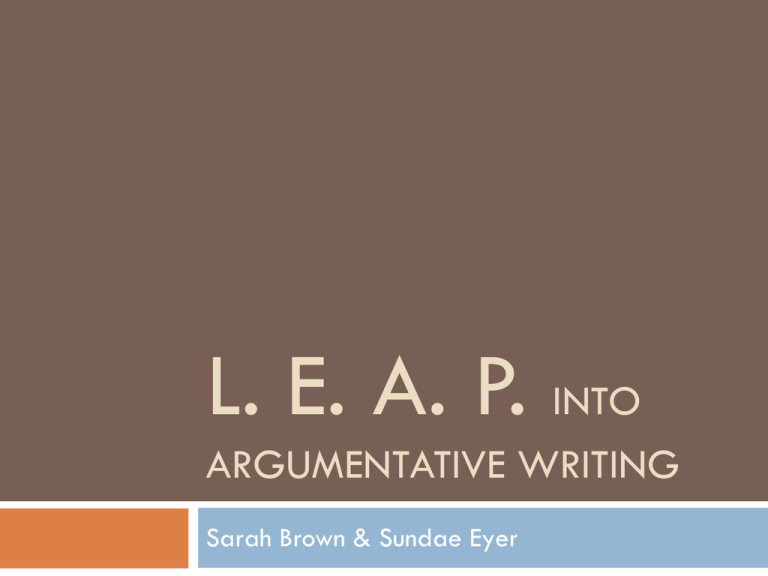
L. E. A. P. INTO ARGUMENTATIVE WRITING Sarah Brown & Sundae Eyer Workshop Objectives Help students L. E. A. P. into argumentative writing through these four steps: (L)earn how to define Claim, Evidence, & Reasoning (E)ngage in activities to practice identifying Claim, Evidence, & Reasoning in text (A)pply knowledge of Claim, Evidence, and Reasoning through discussion activities (P)lan & (P)ractice creating a Claim with Evidence & Reasoning in argumentative writing Sign-in list (L)earning to define Claim, Evidence, Reasoning With a partner or group, please come up with your own definitions of claim, counterclaim, reasoning, and evidence on the butcher paper provided. These might be refined as we work through some ideas. (L)earning to define Claim, Evidence, Reasoning Argument - “Super Claim”: The overarching idea of an argumentative essay that makes more than one claim. In some cases, an argument has a single claim, but in sophisticated writing in 8th-12th grade, multiple claims are made. Claim: a simple statement that asserts a main point of an argument (a side) Reasoning: 2 parts – a) the “because” part of an argument and the explanation for why a claim is made; b) the explicit links between the evidence and the claim; the explanation for why a particular piece of evidence is important to the claim and to the argument Evidence: support for the reasoning in an argument; the “for example” aspect of an argument; the best evidence is text-based, reasonable, and reliable. From Angela Orr, WCSD Tips for (L)earning to define Claim, Evidence, Reasoning Start Basic – ice cream flavors, dog/cat, etc. Cl “aim” – what is your purpose or “aim” – what are you trying to prove? Prove it with evidence that you connect directly to your claim – show the reader how or why the evidence proves your claim – Remember reasoning matters! (L)earning to define Claim, Evidence, Reasoning After you introduce evidence into your writing, you must say why and how this evidence supports your argument. What turns a fact or piece of information into evidence is the connection it has with a larger claim or argument: evidence is always evidence for or against something, and you have to make that link clear with reasoning. We should not assume that our readers already know what we are talking about. The audience can’t read our minds: although they may be familiar with many of the ideas we are discussing, they don’t know what we are trying to do with those ideas unless we indicate it through reasoning. Adapted from UNC at Chapel Hill College of Arts and Sciences Writing Center & from Angela Orr, WCSD (E)ngaging Activities to Identify Claim, Evidence, & Reasoning Color Coding Text or student exemplars Paraphrasing/restating Claims, Evidence, and Reasoning Claim/Evidence Jar Claim Strips (matching with evidence or reasoning) (A)pplying Discussion Activities Pair/share Bucketing (categorizing) Structured Academic Controversy Socratic Seminar Philosophical Chairs Fishbowl Jigsaw (and variations) (P)lan & (P)ractice Creating a Claim with Evidence and Reasoning Foldable Outlining (independently or group) *Hamburger Paragraph *Chicken Foot *5.8.8.8.5 model Round Robin (group- one starts with claim, others add evidence in turn and build on each other) Introduction Argument/Super Claim (adapted from Angela Orr, WCSD) • Context • Super Claim • Claim 1, 2, & 3 Claim 1 • Evidence & Reasoning • Evidence & Reasoning • Evidence & Reasoning Claim 2 • Evidence & Reasoning • Evidence & Reasoning • Evidence & Reasoning Claim 3 • Evidence & Reasoning • Evidence & Reasoning • Evidence & Reasoning Conclusion Can Include Counterclaim • Evidence • Counter-Reasoning (the reasoning that explains why this evidence and claim are invalid) Wrap-up CCSS – reconnect to CCSS objectives Resources www.procon.org www.projecttahoe.org Exit Ticket

